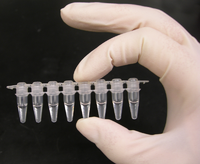
Detection and isolation of SARS‐CoV‐2 Eta variant from the international travelers and local residents of India
Sign Up to like & getrecommendations! Published in 2022 at "Journal of Medical Virology"
DOI: 10.1002/jmv.27676
Abstract: International travel has been the major source for the rapid spread of new SARS‐CoV‐2 variants across the globe. During SARS‐CoV‐2 genomic surveillance, a total of 212 SARS‐CoV‐2 positive clinical specimens were sequenced using next‐generation sequencing.… read more here.
Keywords: international travelers; eta variant; local residents; travelers local ... See more keywords

Alternative clinical specimens for the detection of SARS‐CoV‐2: A rapid review
Sign Up to like & getrecommendations! Published in 2020 at "Reviews in Medical Virology"
DOI: 10.1002/rmv.2185
Abstract: The collection of nasopharyngeal swabs to test for the presence of severe acute respiratory syndrome coronavirus 2 (SARS‐CoV‐2) is an invasive technique with implications for patients and clinicians. Alternative clinical specimens from the upper respiratory… read more here.
Keywords: detection; ranged 100; detection sars; clinical specimens ... See more keywords

A New Solid Matrix for Preservation of Viral Nucleic Acid from Clinical Specimens at Ambient Temperature.
Sign Up to like & getrecommendations! Published in 2019 at "Journal of virological methods"
DOI: 10.1016/j.jviromet.2019.113732
Abstract: Stabilizing paper matrix methods for retaining nucleic acid from inactivated clinical specimens offer a solution for molecular diagnostics when specimens may be stored or shipped at ambient temperature. We developed cellulose disks (UNEXP) saturated with… read more here.
Keywords: temperature; matrix; clinical specimens; ambient temperature ... See more keywords

Rapid genomic characterization of SARS-CoV-2 viruses from clinical specimens using nanopore sequencing
Sign Up to like & getrecommendations! Published in 2020 at "Scientific Reports"
DOI: 10.1038/s41598-020-74656-y
Abstract: The novel SARS-CoV-2 outbreak has swiftly spread worldwide. The rapid genome sequencing of SARS-CoV-2 strains has become a helpful tool for better understanding the genomic characteristics and origin of the virus. To obtain virus whole-genome… read more here.
Keywords: rapid genomic; genomic characterization; clinical specimens; characterization sars ... See more keywords

Evaluation of HPV16 E7 expression in head and neck carcinoma cell lines and clinical specimens
Sign Up to like & getrecommendations! Published in 2020 at "Scientific Reports"
DOI: 10.1038/s41598-020-78345-8
Abstract: Human papillomavirus (HPV) 16 infection in the oropharynx is one of the major risk factors for oropharyngeal carcinoma. Although the HPV E6 and E7 proteins are known to have a role in head and neck… read more here.
Keywords: lines clinical; cell lines; clinical specimens; expression ... See more keywords

Development and Validation of Specific Conventional PCR and Real-Time PCR Assays for Rapid Detection/Identification of C. auris from Yeast Isolates and Clinical Specimens.
Sign Up to like & getrecommendations! Published in 2022 at "Mycoses"
DOI: 10.1111/myc.13504
Abstract: BACKGROUND The accurate occurrence rate of C. auris infections is still not clear, mainly due to defects in detection and identification tools routinely used. In this study, we used conventional PCR and real-time PCR assays… read more here.
Keywords: conventional pcr; identification; clinical specimens; detection identification ... See more keywords

Analytical and Clinical Sample Performance Characteristics of the Onclarity Assay for the Detection of Human Papillomavirus
Sign Up to like & getrecommendations! Published in 2020 at "Journal of Clinical Microbiology"
DOI: 10.1128/jcm.02048-20
Abstract: The objective of this study was to determine the result reproducibility and performance of the BD Onclarity human papillomavirus (HPV) assay (Onclarity) on the BD Viper LT platform using both contrived and clinical specimens. Reproducibility… read more here.
Keywords: performance; clinical specimens; cytology; human papillomavirus ... See more keywords

In Vivo Generation of BK and JC Polyomavirus Defective Viral Genomes in Human Urine Samples Associated with Higher Viral Loads
Sign Up to like & getrecommendations! Published in 2021 at "Journal of Virology"
DOI: 10.1128/jvi.00250-21
Abstract: Defective viral genomes (DVGs) can have a significant impact on the production of infectious virus particles. DVGs have only been identified in cultured viruses passaged at high multiplicities of infection and RNA viruses collected from… read more here.
Keywords: dvgs; viral genomes; clinical specimens; defective viral ... See more keywords

Prospective Study of the Detection of Bacterial Pathogens in Pediatric Clinical Specimens Using the Melting Temperature Mapping Method
Sign Up to like & getrecommendations! Published in 2022 at "Microbiology Spectrum"
DOI: 10.1128/spectrum.00198-22
Abstract: This study provides novel insights regarding the use of the melting temperature (Tm) mapping method to identify the dominant bacteria in samples collected from pediatric patients. We designed a new set of primers for commercial… read more here.
Keywords: clinical specimens; mapping method; temperature mapping; melting temperature ... See more keywords

Paradigm for diagnosing mycobacterial disease: direct detection and differentiation of Mycobacterium tuberculosis complex and non-tuberculous mycobacteria in clinical specimens using multiplex real-time PCR
Sign Up to like & getrecommendations! Published in 2018 at "Journal of Clinical Pathology"
DOI: 10.1136/jclinpath-2017-204945
Abstract: Aims Mycobacterium tuberculosis and non-tuberculous mycobacteria (NTM) are clinically different, and the rapid detection and differentiation of M. tuberculosis complex (MTBC) and NTM is crucial for patient management and infection control. Given the slow growth… read more here.
Keywords: multiplex real; real time; time pcr; clinical specimens ... See more keywords

P859 Genotyping gyrA and penA from remnant neisseria gonorrhoeae positive cepheid xpert® clinical specimens
Sign Up to like & getrecommendations! Published in 2019 at "Sexually Transmitted Infections"
DOI: 10.1136/sextrans-2019-sti.901
Abstract: Background Neisseria gonorrhoeae (NG) has developed resistance to most antibiotics, making it increasingly difficult to treat. Molecular methods have been used to predict antimicrobial susceptibility based on the gyrA codon serine 91 and the mosaic… read more here.
Keywords: gyra; cepheid xpert; clinical specimens; neisseria gonorrhoeae ... See more keywords